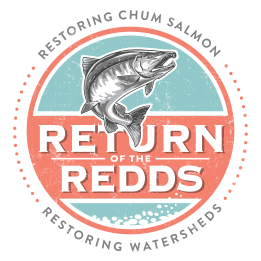Return of the Redds: OVerview
Introducing Return of the Redds, an exciting new collaboration between the North Coast Watershed Association, local landowners, the forest products industry, nonprofits, state and federal agencies all united around a common goal: To revitalize the once abundant Big Creek and Youngs Bay watersheds and chum salmon populations.
Why Chum? Because chum are some of the hardest workers of the salmon family and their aggressive spawning behavior can actually help repair lower watershed health. Historically, they returned here by the thousands and, after creating their “redds” and spawning, their carcasses fed everything from eagles and bears to the very chinook, coho and trout that define our great community.
Our plan began in January 2021 and will continue into the future along two parallel tracks: One, restoring the habitat structure by adding large woody debris, increasing off-channel wetlands, protecting riparian areas and even removing invasive species and replanting native vegetation. And two, we’ll collaborate with private timber companies, land trusts and landowners to build healthy ecological processes into the future.
The map below illustrates the two project areas, Youngs Bay and Big Creek, which include the Big, Gnat, Little, and Bear Creeks and the Lewis and Clark, Skipanon, Youngs, Wallooskee, and Klaskanine Rivers.
Basic project details:
Timing: Stream assessments begin in 2021 and habitat restoration begins in 2022
Goal: To restore habitat and increase local chum salmon populations
Funded by: State, federal and nonprofit partners
Financial cost to landowners: $0
Timeline: two parallel tracks
Restoring Structure:
A top priority is getting landowner permissions to add big trees, or what we call large woody debris (LWD), to the river. Once in place, LWD acts as an anchor of sorts, holding up gravel that might normally just wash downriver. Through a series of high-water events, LWD can quickly turn a channelized, sluicing river back into the more natural, meandering pools and riffles we remember from way back when. While we’re getting more LWD into the lower-river reaches, we’ll also be hard at work increasing off-channel wetlands, protecting riparian areas and floodplains, and even removing invasive species and replanting native vegetation.
Restoring Processes:
A longer-term approach toward process-based restoration, again collaborating with landowners. Here, we’ll work with private timber companies, landowners and land trusts to identify areas we can improve. That might include projects like stream surveys, building new partnerships, working together with private timber owners to decommission roads no longer in use, or conservation easements. It’s a holistic approach to watershed rehabilitation that will depend on landowner support and involvement every step of the way.
“We’re excited to help restore our creek to how it was in the old days. We want our kids to enjoy its bounty for years to come.”


